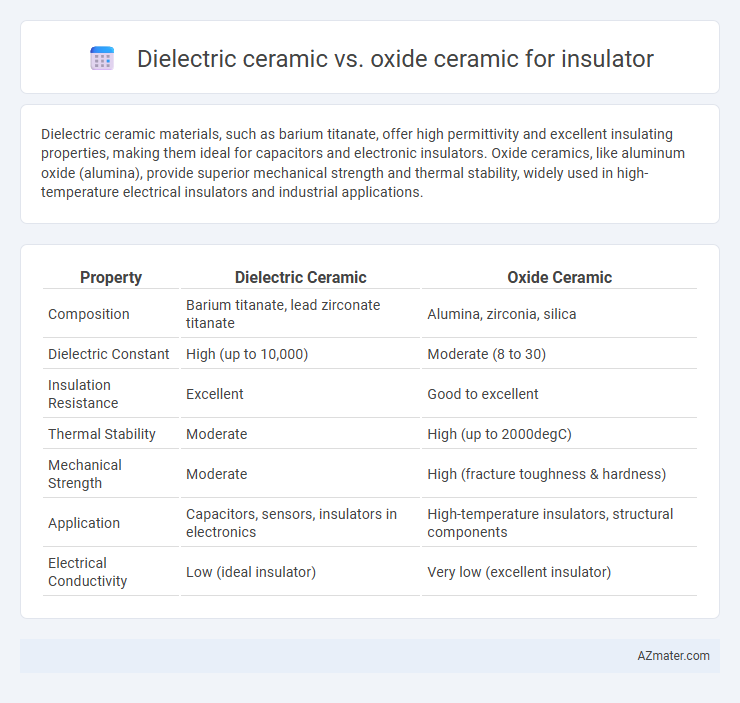Dielectric ceramic materials, such as barium titanate, offer high permittivity and excellent insulating properties, making them ideal for capacitors and electronic insulators. Oxide ceramics, like aluminum oxide (alumina), provide superior mechanical strength and thermal stability, widely used in high-temperature electrical insulators and industrial applications.
Table of Comparison
| Property | Dielectric Ceramic | Oxide Ceramic |
|---|---|---|
| Composition | Barium titanate, lead zirconate titanate | Alumina, zirconia, silica |
| Dielectric Constant | High (up to 10,000) | Moderate (8 to 30) |
| Insulation Resistance | Excellent | Good to excellent |
| Thermal Stability | Moderate | High (up to 2000degC) |
| Mechanical Strength | Moderate | High (fracture toughness & hardness) |
| Application | Capacitors, sensors, insulators in electronics | High-temperature insulators, structural components |
| Electrical Conductivity | Low (ideal insulator) | Very low (excellent insulator) |
Introduction to Dielectric and Oxide Ceramics
Dielectric ceramics, characterized by high permittivity and low dielectric loss, are essential for efficient energy storage and signal isolation in electronic components. Oxide ceramics, such as aluminum oxide and zirconium oxide, exhibit excellent mechanical strength, thermal stability, and electrical insulation properties, making them ideal insulators. Both materials are widely used in insulator applications, but dielectric ceramics prioritize electrical performance while oxide ceramics emphasize durability and stability.
Fundamental Properties of Dielectric Ceramics
Dielectric ceramics exhibit high permittivity, low dielectric loss, and excellent insulation resistance compared to oxide ceramics, making them ideal for insulating applications. Their fundamental properties include stable dielectric constant, high breakdown voltage, and strong thermal stability under varying environmental conditions. These characteristics result from their complex crystal structures, such as perovskite or titanate phases, which enhance polarizability and electrical insulation performance.
Key Characteristics of Oxide Ceramics
Oxide ceramics, such as alumina and zirconia, exhibit high dielectric strength, excellent thermal stability, and superior corrosion resistance, making them ideal insulators in high-temperature and high-voltage applications. Their low dielectric loss and high breakdown voltage enhance performance in electronic components, while their mechanical hardness and chemical inertness ensure durability and reliability. Compared to dielectric ceramics, oxide ceramics offer enhanced electrical insulation properties combined with robust structural integrity in demanding environments.
Comparative Electrical Performance
Dielectric ceramics exhibit higher permittivity and lower dielectric loss compared to oxide ceramics, making them more efficient insulators in high-frequency applications. Oxide ceramics generally provide better thermal stability and voltage resistance but suffer from higher dielectric losses under AC conditions. The superior dielectric breakdown strength of dielectric ceramics enables enhanced insulation performance in electronic devices.
Thermal Stability and Resistance
Dielectric ceramics exhibit superior thermal stability with higher Curie temperatures, allowing consistent insulating performance under extreme heat compared to oxide ceramics. Oxide ceramics typically offer excellent resistance to chemical corrosion but may experience phase transitions at elevated temperatures that reduce insulation reliability. The enhanced thermal stability and dielectric strength of dielectric ceramics make them preferable for high-temperature insulator applications where maintaining electrical isolation under thermal stress is critical.
Mechanical Strength and Durability
Dielectric ceramics typically offer higher mechanical strength and better resistance to cracking under stress due to their dense microstructure, making them ideal for high-stress insulator applications. Oxide ceramics, such as alumina and zirconia, provide excellent durability and thermal stability but generally exhibit lower fracture toughness compared to advanced dielectric ceramics. The choice between dielectric and oxide ceramics depends on the specific mechanical load requirements and environmental conditions of the insulator's application.
Applications in Electrical Insulation
Dielectric ceramics such as barium titanate and titanium dioxide offer high permittivity and are extensively used in capacitors and electronic insulators requiring excellent dielectric properties. Oxide ceramics, including alumina (Al2O3) and zirconia (ZrO2), provide superior mechanical strength and thermal stability, making them ideal for high-voltage insulators and harsh environment electrical insulation. Both materials serve critical roles in electrical insulation, with dielectric ceramics optimized for electronic components and oxide ceramics favored in power transmission and industrial applications.
Manufacturing Processes and Material Costs
Dielectric ceramics typically require complex manufacturing processes such as tape casting, high-temperature sintering, and precise doping to achieve optimal electrical properties, resulting in higher production costs compared to oxide ceramics. Oxide ceramics, commonly produced using simpler powder compaction and sintering methods, benefit from abundant raw materials like alumina and zirconia, leading to lower material costs. Manufacturing efficiencies and the choice of ceramic type directly impact the final cost and performance suitability for insulating applications in electronics and high-voltage systems.
Environmental Impact and Longevity
Dielectric ceramics typically contain non-toxic materials and exhibit high durability, reducing environmental waste through longer service life and less frequent replacement. Oxide ceramics, such as aluminum oxide or zirconia, offer exceptional chemical stability and resistance to corrosion, minimizing environmental degradation during disposal. Both materials provide significant longevity in insulator applications, but oxide ceramics generally outperform in harsh environments, enhancing sustainability by lowering the need for maintenance and replacement.
Choosing the Best Ceramic for Insulator Applications
Dielectric ceramics like titanium dioxide offer high permittivity and excellent insulation at high frequencies, making them ideal for advanced electronic insulators, whereas oxide ceramics such as alumina provide superior mechanical strength and thermal stability crucial for harsh environment applications. Selecting the best ceramic insulator depends on balancing dielectric constant, temperature tolerance, and mechanical durability to suit specific operational conditions. For high-performance electronics, dielectric ceramics optimize signal integrity, while oxide ceramics ensure longevity and robustness in industrial insulators.

Infographic: Dielectric ceramic vs Oxide ceramic for Insulator
 azmater.com
azmater.com